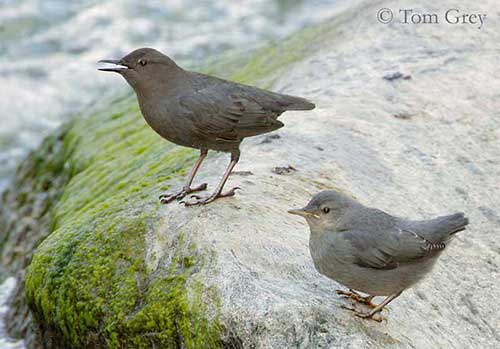
American Dipper
Cinclus mexicanus
Passeriforme Order - Cinclidae Family
BIOMETRICS:
Length: 18-20 cm; Wingspan: 23 cm; Weight: 43-67 g
LONGEVITY: up to 5 years
DESCRIPTION:
American Dipper is also named “Water Ouzel”.
Adult has slate-grey body. It is a stocky bird with short tail and wings.
The large head is browner. Eyes are dark brown with white transparent eyelids. Pointed, slender bill is blackish, paler at the base. Long legs and feet are pale pinkish-brown.
Both sexes are similar, with male larger than female.
Juvenile is paler than adults. Streaked underparts are whitish on chin and throat, increasing in colour on breast, and becoming browner on belly and vent. Bill is pale and legs are pinkish.

VOICE: SOUNDS BY XENO-CANTO
American Dipper utters a loud, musical song, with repeated notes, high pitched whistles and trills. Call is a sharp “zeet”. American Dipper’s song is similar to the best sounds of thrushes and wrens.
Both sexes sing all year round, except when young are fledging.
HABITAT:
American Dipper lives and breeds along small turbulent mountain streams within wooded area, where it gets food. It needs clear and unpolluted fast moving waters to find its preys.
RANGE:
American Dipper lives and breeds in North America, from Alaska, through Mountain West, and southwards to Panama.
During winter, it only performs local movements and dispersions, to find unfrozen waters at lower elevation. They concentrate in great numbers, using narrow creeks and slow-moving waters.
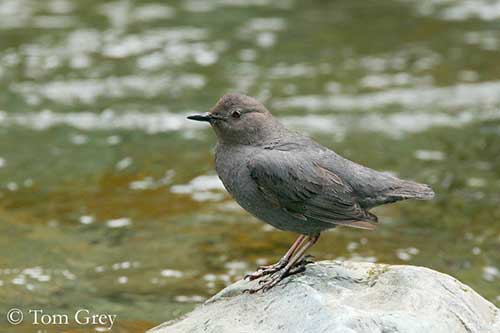
BEHAVIOUR:
American Dipper is well adapted for its life-style underwater. It does not have webbed feet, but it swims and propels its body with the wings, and by padding with legs and feet. It may walk on the bottom, grasping the stones with its toes, and using its semi-open wings to maintain its body submerged. It bobs entire body up and down during pauses, while feeding on the bottom of the streams. It dives head first, and propels itself with or against the current.
Water cannot enter the nostrils because it has nasal flaps, a kind of scales. It preens extensively and obtains oil for waterproofing its feathers from large glands above the tail. American Dipper is able to see underwater. It has an eyelid (nictating membrane) allowing it to see its preys in the water. It also may store more oxygen in its blood than other non-diving species. Dipper has dense plumage with greater number of feathers and more down, for diving in cold waters in winter with good insulation.
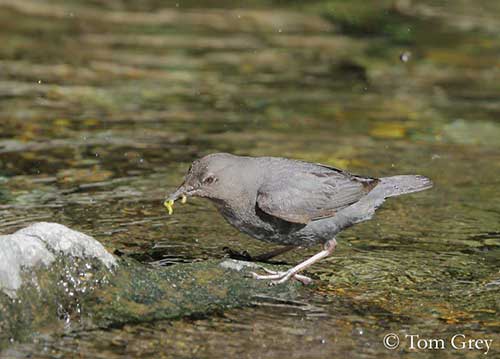
During winter, American Dipper forages for food in intertidal portions of streams along saltwater beaches. It also may catch flying insects by flycatching, by skimming emerged preys, or performing short round-trips after insects.
American Dipper is highly territorial, defending a linear territory along streams all year round. When alarmed, it performs flattening out, and remains motionless on the surface. Its grey colour provides it good camouflage. The bird bends its legs and its entire body moves up and down in dipping motion.
It is rarely seen away from water, but it may disperse across adjacent areas. Except during breeding season, American Dipper is solitary.
They are usually monogamous, but when nest-sites are concentrated, males may have two mates. Dipping and bobbing are used in displays during breeding season, and males sing to attract females.
FLIGHT:
American Dipper performs a strong direct flight, with rapid wing beats. It avoids flying over lands, preferring to fly along streams, following each bend of the water.
REPRODUCTION:
American Dipper’s nest is a globe-shaped structure. We can see a side entrance facing the water. Nest is located on a rock ledge, on river bank, often hidden behind a waterfall or under a bridge. Nest is covered with mosses and built with grasses and leaves. Female lines it with grass, or pine needles, leaves and bark strips. Male often helps her to build the nest. It may size up to 30 cm in diameter.
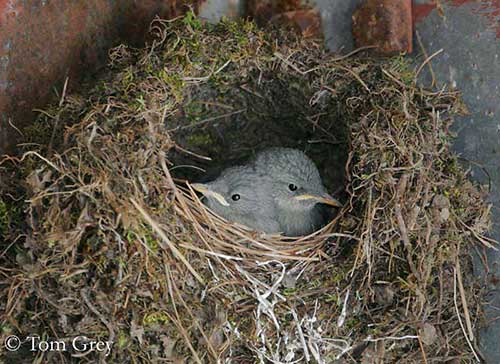
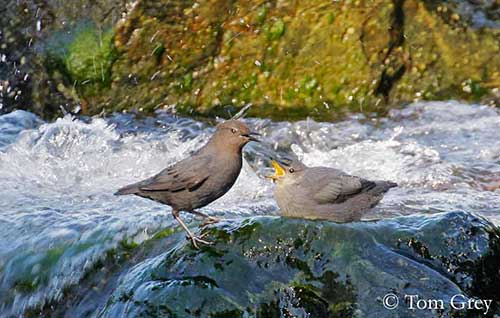
Female lays 2 to 4 white eggs. Incubation lasts about 15 to 17 days, by female alone. Male feeds her during this period.
Altricial chicks are fed by both parents and female broods them during one week. Young fledge at about 20 to 25 days and they are able to swim and dive. They are fed by both adults 24 days more after they leave the nest.
This species may produce two broods per year, and pair may use the same nest.
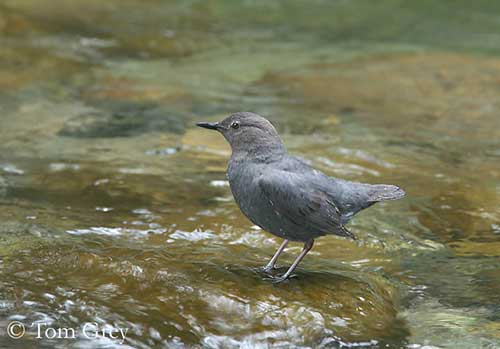
DIET:
American Dipper feeds on insects, aquatic invertebrates, small fishes and fish-eggs. It also feeds on small larval amphibians.
PROTECTION / THREATS / STATUS:
American Dippers need very clear and unpolluted waters to find their preferred food. They cannot feed in streams where heavy sediments occur. Stream banks are damaged by cattle, and destroyed riparian vegetation increases sedimentation and warming of stream water.
Habitat loss by roads built along water has also severe effect by increasing of sedimentation.
Dippers are preyed upon by raptors and mammals, but also by large fishes pursuing the birds across water.
Fr: Cincle d’Amérique
All : Grauwasseramsel
Esp : Mirlo Acuático Americano
Ital : Merlo acquaiolo del Nordamerica
Nd : Noordamerikaanse Waterspreeuw
Sd : Grå strömstare
Photographs by Tom grey
His website: Tom Grey's Bird Pictures
Text by Nicole Bouglouan
Sources:
HANDBOOK OF THE BIRDS OF THE WORLD Vol 10 by Josep del Hoyo-Andrew Elliott-David Christie - Lynx Edicions - ISBN: 8487334725
FIELD GUIDE TO THE BIRDS OF NORTH AMERICA - National Geographic Society - ISBN: 0792274512
All About Birds (Cornell Lab of Ornithology)
Animal Diversity Web (University of Michigan Museum of Zoology)
Wikipedia (Wikipedia, The Free Encyclopedia)
What Bird-The ultimate Bird Guide (Mitchell Waite)
South Dakota Birds and Birding (Terry L. Sohl)
Bird Web (Seattle Audubon Society)